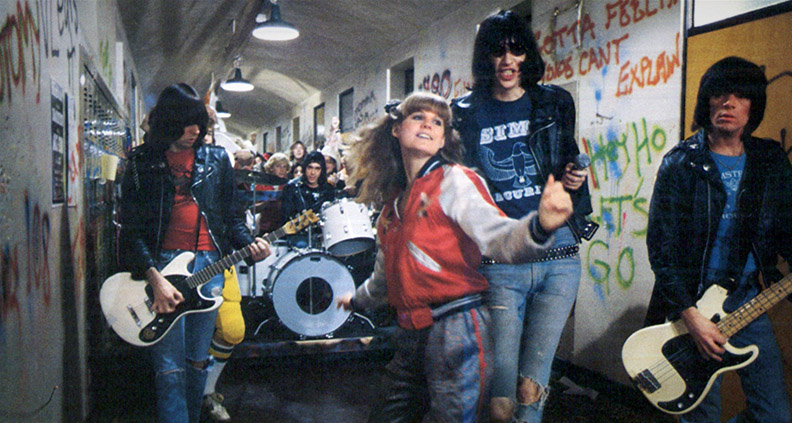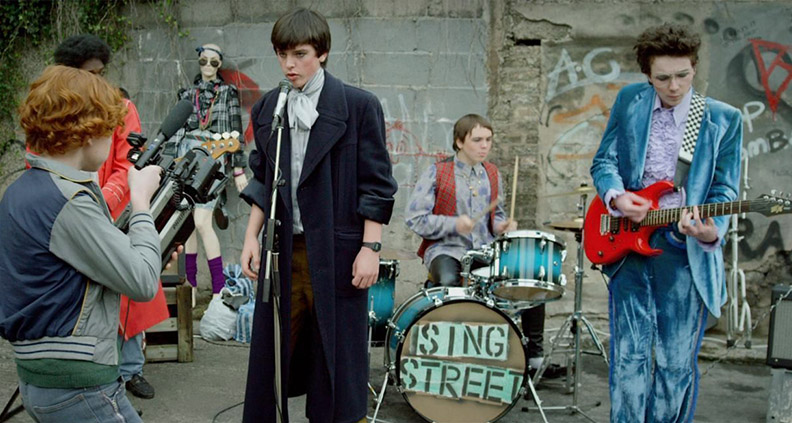Old v. New: Rock, Pop and Teenage Rebellion in ‘Sing Street’ and ‘Rock ‘n’ Roll High School’
In our regular feature Old v. New, Kimberly Marcela Duron compares a newer independent release with an older classic to see what similarities they share, how they diverge and hear what the conversation between the two films says about filmmaking as the art form continues to innovate and evolve.
***
For much of Hollywood’s Golden Age, musical comedies were a sure-fire way to make a hit—especially if the poster had a name like Gene Kelly, Debbie Reynolds (RIP) or Fred & Ginger. But somewhere along the way, as film evolved to begin exploring new subject matters and formal techniques, musical comedies gradually seemed to lose both their sparkle and their reach.
But even within the broader category of “musicals,” there are subgenres that have continued to experience some level of distinction and success over the years. Take for instance “jukebox musicals” set to the songs of a particular band, like Mamma Mia (ABBA), Across the Universe (The Beatles) or the Roger Corman-produced Rock ‘n’ Roll High School. Released in 1979, High School concerns a group of rebellious teens at an all-American high school—“Vince Lombardi High School”—that fights their oppressive principal to music of New York punk icons the Ramones. The film also features songs from Alice Cooper, Fleetwood Mac and The Velvet Underground. But the plot of High School fits best with the songs and lyrics of the Ramones, still relatively unknown at the time. Much like the band itself, the film slowly attained cult-classic status, quite fittingly going on to become the first feature-length film to be aired on MTV.
A rock-filled soundtrack isn’t nearly as common in musical comedies. Which is perhaps what makes director John Carney’s 2016 release Sing Street so unique. The film tells the story of Conor, a shy teen in 1980s Dublin who starts a band to impress a girl and begins forming his identity in the process. Sing Street features classic tracks from groups like Hall & Oates, Duran Duran and The Clash, as well as original tracks composed for “Sing Street”—the titular band formed by Conor and named after the location of their oppressive parochial academy (shades of Rock ‘n’ Roll High School)—written by Gary Clark and various other artists, including Carney himself.
https://www.youtube.com/watch?v=C_YqJ_aimkM
Rock ‘n’ Roll High School and Sing Street are very different in terms of music they champion: punk in one, mainstream pop/rock in the other. The similarity between the two films stems from the depiction of the ways teenagers use music to distinguish themselves against adults, just like any generation that turns to counterculture in rebellion. And in the early-to-mid-1980s teens turned to rock. In Sing Street, Conor describes his “futurist style” as “no nostalgia—not your da’s band”. In High School, part of the students’ excitement about The Ramones is that the band drives the adults in the film insane. One of the initial titles for the film was Disco High, but the movie evolved into its full punk-rock glory when the producers realized disco didn’t upset parents. Rock did. The result was a teenage exploitation film—something a bored student would daydream about during detention. It’s a simple concept: watching the trailer you get all the most exciting bits of the film in one fell swoop, from the table-dancing-at-lunch scenes all the way down to movie’s literally-explosive climax. But both films embrace the concept that, as Conor’s older brother Brendan advises, “Rock ‘n’ roll is a risk. You risk being ridiculed.” The misfit group of kids in each film learns to take this risk with pride.

Nevertheless, Sing Street contains an extra dimension missing from High School: drama. Boiled down, the film is a coming-of-age tale about finding your identity and navigating life’s problems through music, friendship and love. It just so happens to be a rad musical, too. A large portion of the film is shot in medium- and close-up shots, something that draws you in past Conor’s teenage angst. The film becomes more intimate with escalating moments of self-realization and discovery about the real world; exploring subjects like failed relationships, dreams that are never fulfilled and darker things like domestic abuse and repressive religious cultures. It’s also nostalgic about the quotidian way of life pre-mobile phones, making Conor’s blossoming friendship with his new bandmates all the more meaningful. In High School there’s viable friendship between Riff Randall (P.J. Soles), the free-spirited #1 Ramones superfan, and Kate Rambeau (Dey Young), the chemistry nerd with oversized glasses, who covers up for Riff when she skips school. They have each other’s backs when it comes to boys and rebelling—but probably not in any real-world things like family or money.

In both films, the filmmakers make choices that reflect their own vision and style, as well as that effect story development. Sing Street sees a repetition of shots throughout the film in which Conor walks into the school’s courtyard. First, he’s alone and self-conscious as the new kid in school. Later, he’s given himself a David Bowie-inspired makeover. In the last few shots, he leads his bandmates with confident strides, looking like Pretty in Pink’s Duckie with tiny round glasses and blazer with rolled-up sleeves. The shots mark different beats in his character arc in a subtle-but-catchy ‘80s film way. Rock ‘n’ Roll High School, on the other hand, uses wipes in all shapes and forms—like hearts and stars—as transitions between scenes, as well as distinctive composition to make the military-like Principal Togar (Mary Woronov) seem crazy and over-bearing. It shows you exactly what it wants to be: a rowdy B-movie about a girl who takes on the system and becomes an honorary Ramone in the process.
Neither of the two films feature the cast breaking into song and dance mid-sentence; the revelry is usually prompted by the start of a song on a cassette or record player. One film lies on the edge of amusing absurdity, while the other remains realistic and relatable. But both indies tackle the genre convention and make them their own—and that’s what makes either film one to appreciate. Rock on.
To learn more about Film Independent, subscribe to our YouTube channel or follow us on Twitter and Facebook. You can catch up with the rest of our blog here. To learn how to become a Member of Film Independent, just click here.